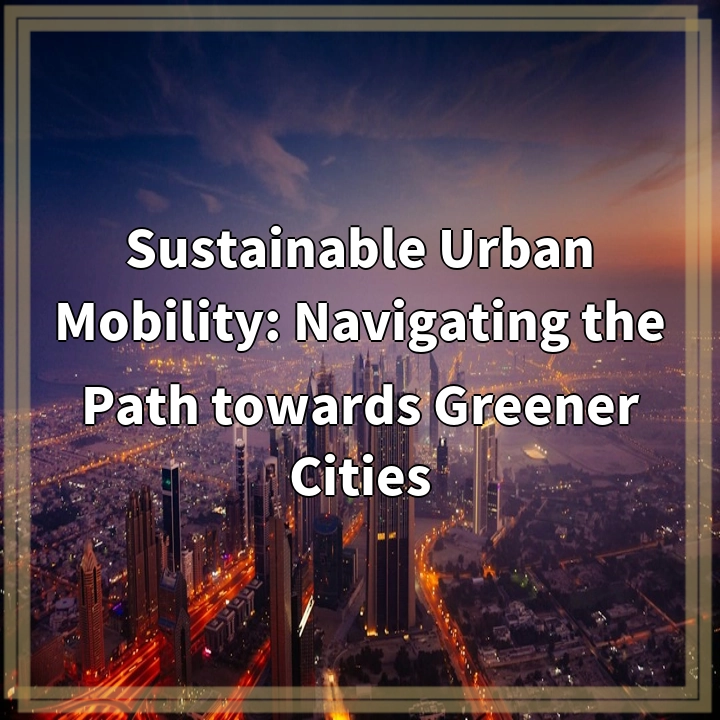
What is Sustainable Urban Mobility?
Sustainable Urban Mobility refers to the transportation systems and services in urban areas that prioritize environmental, social, and economic sustainability. It aims to provide efficient and accessible transportation options while minimizing negative impacts on the environment and improving the overall quality of life in cities.
Real-World Problems Associated with Sustainable Urban Mobility
1. Traffic Congestion: Rapid urbanization has led to increased traffic congestion in many cities worldwide. This not only wastes time and increases commute stress but also contributes to air pollution and greenhouse gas emissions.
2. Air Pollution: Urban mobility heavily relies on fossil fuel-powered vehicles, which are major contributors to air pollution. The emissions from cars, buses, and motorcycles lead to poor air quality and have adverse effects on public health.
3. Lack of Accessibility: Not all urban areas have efficient and accessible transportation options, especially in marginalized communities. Limited access to public transportation can hinder mobility, social inclusion, and economic opportunities for certain groups of people.
4. Inadequate Infrastructure: Many cities lack proper infrastructure to support sustainable modes of transportation, such as cycling lanes, pedestrian walkways, and well-designed public transportation systems. This makes it challenging for individuals to choose greener mobility options.
5. Dependence on Single-Occupancy Vehicles: The prevalence of private car usage in urban areas contributes to excessive traffic congestion and air pollution. Encouraging alternatives like carpooling and expanding public transportation options can help reduce dependency on private vehicles.
6. Limited Funding and Resources: Implementing sustainable urban mobility initiatives often requires significant investments in infrastructure, technology, and policy changes. Limited funding and resources can present challenges in implementing large-scale sustainable mobility projects.
7. Resistance to Change: Overcoming resistance from various stakeholders can be a major hurdle in implementing sustainable urban mobility solutions. This includes convincing individuals to adopt alternative modes of transport and gaining support from policymakers and transportation authorities.
8. Inequality and Social Exclusion: Sustainable urban mobility initiatives should prioritize equity and inclusivity. Ensuring equal access to transportation options for all socioeconomic groups and marginalized communities is essential to avoid exacerbating existing inequalities.
By addressing these real-world problems associated with sustainable urban mobility, we can pave the way towards greener cities that prioritize environmental sustainability, social equity, and enhanced quality of life for urban dwellers.

Solutions for Sustainable Urban Mobility
There are various solutions and strategies that can be implemented to address the real-world problems associated with sustainable urban mobility:
1. Investing in Public Transportation:
Increasing the availability, reliability, and efficiency of public transportation systems can encourage more people to use mass transit, reducing the reliance on private vehicles.
2. Promoting Active Mobility:
Investing in pedestrian-friendly infrastructure, cycling lanes, and bike-sharing programs can promote walking and cycling as modes of transportation, reducing congestion and emissions.
3. Implementing Carpooling and Ride-Sharing:
Encouraging carpooling and ride-sharing services can help reduce the number of single-occupancy vehicles on the road, easing traffic congestion and reducing carbon emissions.
4. Electrification of Transportation:
Accelerating the transition to electric vehicles (EVs) can significantly reduce air pollution and greenhouse gas emissions. Supporting EV infrastructure and providing incentives for EV adoption are important steps.
5. Prioritizing Integrated Planning:
Integrating land use and transportation planning can ensure that transportation systems are well-connected to residential, commercial, and recreational areas, reducing the need for extensive travel.
6. Enhancing Connectivity and Information:
Using technology to improve transportation connectivity, providing real-time information about routes, schedules, and traffic updates can help individuals make informed choices and reduce travel time.
7. Encouraging Behavior Change:
Implementing awareness campaigns, educational programs, and incentives can encourage individuals to choose sustainable mobility options and change their travel behavior.
8. Collaboration and Policy Support:
Collaboration between various stakeholders including government authorities, transportation agencies, urban planners, and communities is essential. Supportive policies, regulations, and funding are vital for the successful implementation of sustainable urban mobility solutions.
By implementing these solutions, cities can navigate the path towards greener and more sustainable urban mobility, mitigating environmental impacts, improving air quality, enhancing accessibility, and promoting a higher quality of life for all residents.















